|
IFUGAO:
WARRIOR'S ARM BAND #2
|
|
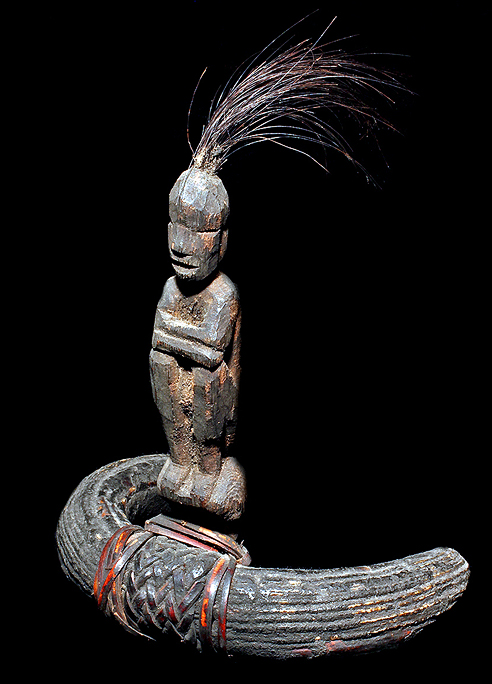
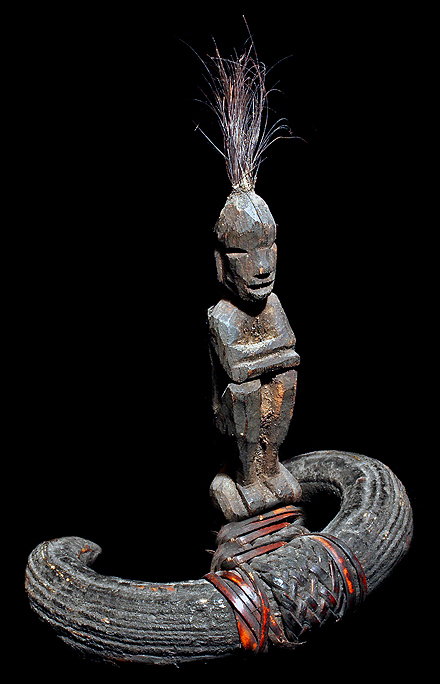
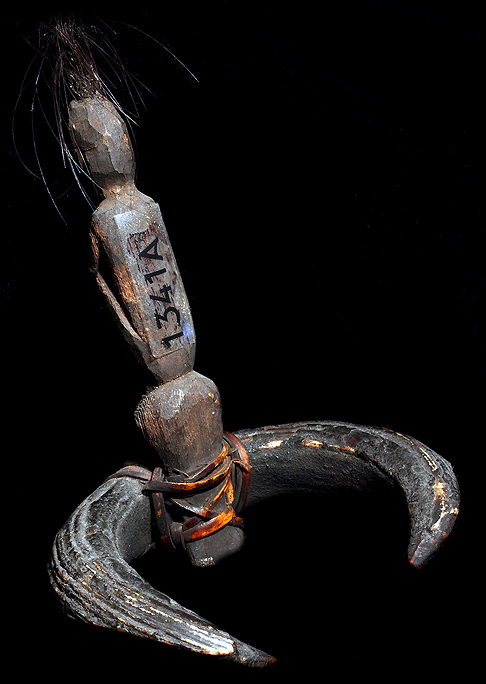
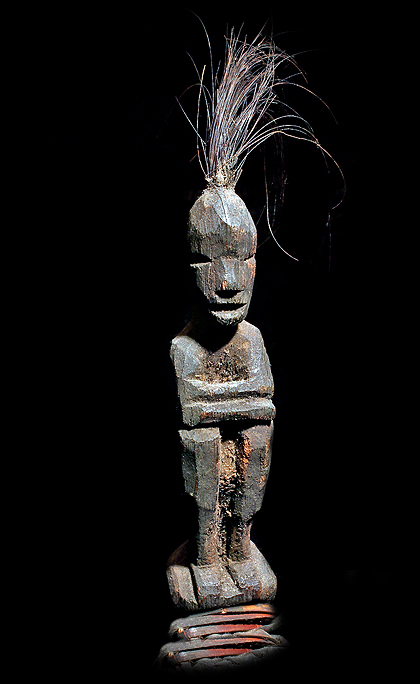
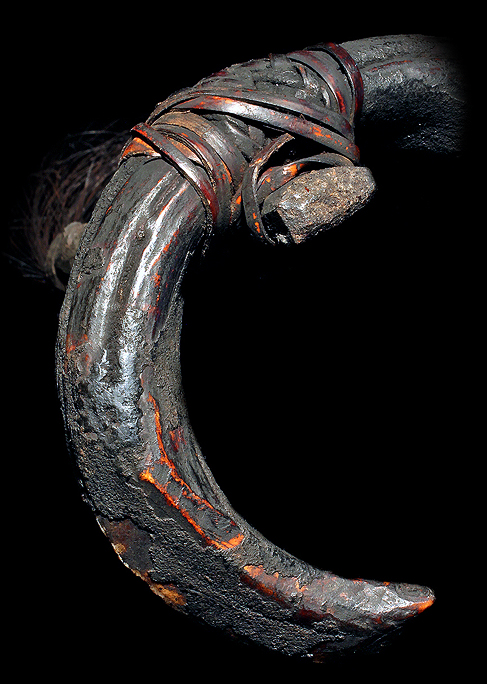
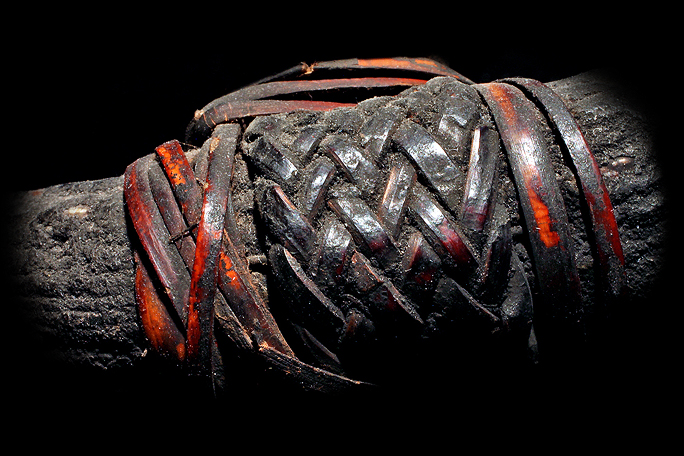
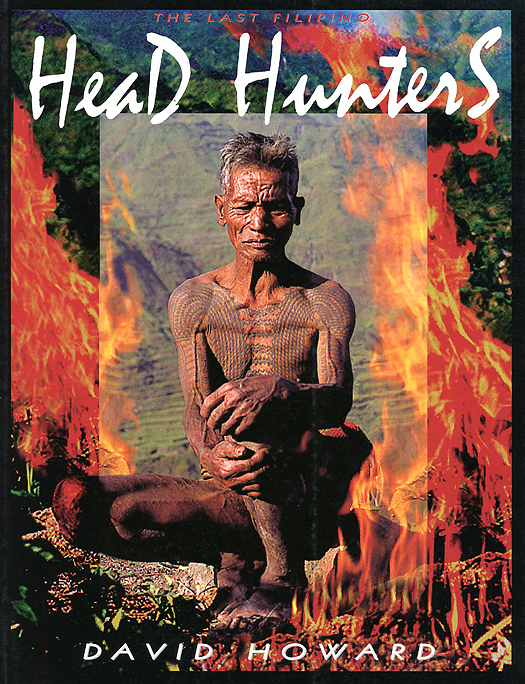
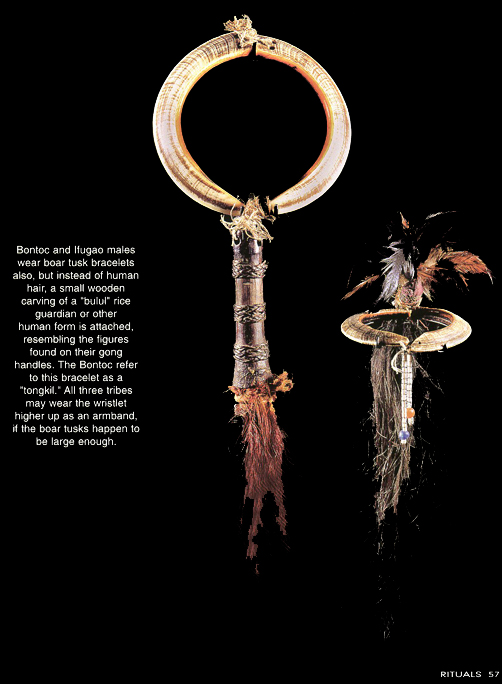

IFUGAO TRIBE: WARRIOR'S ARM BAND #2
HAND CARVED "BULUL" FIGURE,
BOAR TUSKS, FIBER, WOOD, BOAR HAIR, RATTAN
IFUGAO TRIBAL USED ANTIQUE
19TH CENTURY WARRIOR'S
“TONGKIL” BOAR TUSK BRACELET WITH HAND CARVED WOODEN BULUL FIGURE;
CIRCA 1880! AUTHENTIC ANTIQUE IFUGAO
HEAD HUNTING
WARRIOR'S BRACELET THAT FEATURES A SEATED HAND CARVED “BULUL” HUMAN
FIGURE RATTAN LASHED ONTO TWO BOAR TUSKS. FROM THE HEAD HUNTING TRIBE:
"IFUGAO" IN THE CORDILLERA MOUNTAINS ON
THE ISLAND "LUZON" IN THE PHILIPPINES. IT IS IN EXCELLENT CONDITION
WITH A FINE, RICH, DARK
PATINA. MEASURING 11
INCHES IN CIRCUMFERENCE, X 4.5 INCHES TALL, X 3.5 INCHES DEEP. SHOWS
WEAR AND SIGNS OF TRIBAL USE. FOR
SIMILAR
EXAMPLES: PLEASE REFERENCE THE BOOK ENTITLED: "THE LAST FILIPINO HEAD
HUNTERS;" PAGE # 57 IN THE ABOVE ARE POSTED PICTURES OF THAT BOOK’S
COVER AND MENTIONED PAGE NUMBER FOR YOUR REFERENCE. THIS IS A RARE AND UNUSUAL
PIECE FROM MY GRANDFATHER'S TRIBAL ART COLLECTION. HE
WORKED IN SOUTHEAST ASIA, SOUTH AMERICA, AND AMERICA'S SOUTH WEST IN
THE 30'S. HE TRAVELED TO BURMA, INDONESIA, THE PHILIPPINES, EUROPE AND
MEXICO WITH A NATIONAL GEOGRAPHIC MAGAZINE PHOTOGRAPHER. HE COLLECTED
THIS
PIECE DURING HIS TRAVELS.
Headhunting
is the practice of taking and
preserving a person's
head after killing the person. Headhunting was practised
in historic times in parts of Oceania, South and Southeast
Asia, West and Central Africa, and Mesoamerica, as well
as among certain tribes of the Celts, the West Germanic
tribes, and Scythians of ancient Europe. It occurred in
Europe to the end of the Middle Ages in Ireland and the
Anglo-Scottish border regions, and until the 19th century
in Montenegro, Croatia, Albania and
western parts of Herzegovina.
The headhunting practice has been the subject of intense
study within the anthropological community, where scholars
try to assess and interpret its social roles, functions, and
motivations. Anthropological writings explore themes in
headhunting that include mortification of the rival, ritual
violence, cosmological balance, the display of manhood,
cannibalism, prestige by taking on a rival's spirit and power,
and as a means of securing the services of
the victim as a slave in the afterlife.
Today's scholars generally agree that headhunting's primary
function was ritual and ceremonial. It was part of the process
of structuring, reinforcing, and defending hierarchical relationships
between communities and individuals. Some experts theorize that
the practice stemmed from the belief that the head contained
"soul matter" or life force, which could be
harnessed through its capture.
Prior to colonization,
Ifugao was a massive highland plutocracy, among
the most sophisticated and prosperous of its kind in the whole
archipelago and one of the two grandest highland plutocracies in Luzon,
the other being the Plutocracy of Kalinga. The state existed for over
2,000 years and have built massive rice terraces that would be a symbol
of the province in later time. There were no monarchs in the state. The
state was ruled by its council of elders which led the state into a
peaceful and prosperous plutocracy which developed one of the best
agricultural technologies in Asia at its time. The state consisted of
various subgroups which had similar yet somewhat distinct culture and
traditions. Conflicts among the Ifugao people were resolved in the most
peaceful way possible. Unlike most of the highland plutocracies in the
Cordilleras at the time, the Plutocracy of Ifugao had the least
conflict with lowland settlers. Kiangan was known as the birthplace of
the Ifugao people and Hungduan
as the epicenter of its culture.
The Ifugao sacrificial ritual "Punamhan" box
dates back centuries. The classic punamhan form
maintains the traditional rectangular shape associated with the
[typical] punamhan found in the regions of Banaue and Lagawe, which
usually have two zoomorphic head finials (usually of a boar or a dog)
carved on either end. The lid fits snuggly to the container and bears
traces of a stylized gecko, or butiki, motif carved on it. This playful
mix of both anthropomorphic and zoomorphic design elements make for a
very unusual box; one that defies the stylistic tradition of the
typical punamhan associated with rice and harvest rites. All in
all, this archaic specimen remains intact with visible traces of ritual
libations - a well-seasoned ritual object that has been witness to over
a century of
countless harvests and rituals.
"PUNAM-HAN"are
used for rice rituals by Shamans for planting and
harvest rituals; where the blood of butchered animals are pored over
the outside and grains of rice are put inside as offering to the Ifugao
gods thus it is regarded as a sacred tribal ritual object.
A
Bulul is a carved wooden figure used to guard the rice crop by the
Igorot peoples of northern Luzon. The sculptures are highly stylized
representations of ancestors, and are thought to gain power from the
presence of the ancestral spirit. The Ifugao are particularly noted for
their skill in carving bululs. Bululs are used in ceremonies associated
with rice production and with healing. Creation of a bulul involves
alwen bulol ritual by a priest to ensure that the statue gains power.
The bulul is treated with care and respect to avoid the risk of the
spirits of the ancestors bringing sickness. The figures are placed in
rice granaries to bring a plentiful harvest. A large granary may need
two bululs, and a wealthy noble may also have one or more bululs in his
house. Male and female Bulul statues are often found together, with
sex-related symbols such as the mortar for the female and pestle for
the male. A male bulul may sometimes be decorated with a g-string, and
a female with a waist cloth, earrings and anklets. Although the form
varies, the bulul is commonly represented as seated on the ground, with
arms crossed over his upraised knees. The bulul has a simplified form,
and is traditionally carved from narra or ipil wood or sometimes stone.
The bulul is touched by hands dipped in blood of a chicken or pig in
ritual called tunod during the rice planting season. Over time the
blood imparts a dark color to the figures, overlaid with a patina of
grease from food offerings. Bululs are handed down to the first child
of a family. Typically the older statues have beetle holes made by
insects in the granary.
Ifugao
culture revolves around rice, which is considered a prestige
crop. There is an elaborate and complex array of rice culture feasts
inextricably linked with taboos and intricate agricultural rites, from
rice cultivation to rice consumption. Harvest season calls for
grandiose thanksgiving feasts, while the concluding harvest rites
"tungo" or "tungul" (the day of rest) entail a strict taboo of any
agricultural work. Partaking of the rice wine (bayah), rice cakes, and
'moma' (mixture of several herbs, powdered snail shell and betel nut/
arecoline: and acts as a chewing gum to the Ifugaos) is an indelible
practice during the festivities and ritual activitiess. their retual
and Agricultural terracing is their principal means of livelihood along
with farming. Their social status is measured by the number of rice
field granaries, family heirlooms, gold earrings, carabaos (water
buffaloes), as well as, prestige conferred through time and tradition.
The more affluent, known as kadangyan were usually generous by nature,
giving rice to poor neighbors in time of food shortage(s) and/or
hardship(s). Furthermore, their culture was known for their legal
system, using one of the world's most extensive oral legal traditions
specifying the offense depending on the use of custom law; trial by
elders (influenced in part by public opinion); or trial by ordeal. The
wealthy were subjected to greater
fines than the poor.
Untouched
by the influences of Spanish colonialism, Ifugao culture
value kinship, family ties, religious and cultural beliefs. They're
unique among all ethnic groups in the mountain province, not only for
their interesting customs and traditions but also for their narrative
literature such as the hudhud, an epic dealing with hero ancestors sung
in a poetic manner. Another feature unique to the Ifugao is their
woodcarving art, most notably the carved granary guardians bului and
the prestige bench of the upper class, the hagabi. Their textiles
renowned for their sheer beauty, colorful blankets and clothing woven
on looms. Houses were well-built, characterized by as a square with
wooden floors, windowless walls, and pyramidal thatch roofs. Elevated
from the ground by four sturdy tree trunks, they feature removable
staircases that were hoisted up at night to prevent entry by enemies
and/or wild animals. Lastly, their attire remain traditional for male
Ifugaos, donning the wanno or g-string; there are six types of wanno
which are used depending on the occasion or the man's social status.
Ifugao women, on the contrary, wear tapis, a wraparound skirt; there
are five kinds of skirts worn, depending on the occasion.
THE IFUGAO
TRIBE, ON THE ISLAND: LUZON
IN THE PHILIPPINES,
USE
"PUNAMHAN"
HAND CARVED WOODEN
BOXES
THAT ARE
"ACTIVATED" THROUGH RITUAL
ANIMAL
BLOOD SACRIFICE.
THE IFUGAO; ORIGINALLY REFERRED TO AS "IGOROTS" WERE
ONCE THOUGHT TO BE INCLUDED WITH THE BONTOC, KALINGA
KANKANAY, IBALOI AND GADDANG AS A SINGLE TRIBE!
IT WAS NOT UNTIL EXHAUSTIVE RESEARCH LATER REVEALED
THESE WERE INDIVIDUAL TRIBES WITH DISTINCT
CULTURAL DIFFERENCES AND BELIEF SYSTEMS!
|
|
Asian tribal art, artifacts, ifugao, kalinga, bontoc,
asmat, dayak, philippines, asia, head hunters, human trophy skull,
skulls, african, antiques, naga, necklace, headdress, head hunting
trophy skull, Indonesia, Indonesian, SOUTHEAST ASIA, Borneo, Sarawak,
ANTIQUES, Kalimantan, Sulawesi, ART, Sumatra, Timor, ARTIFACTS, Bali,
Java, INDIA, Flores, Sumba, NEPAL, Savu, Roti, BABAS, Lombok, Malaysia.
HOLY MEN, Nusa Tengara, New Guinea, SHAMAN, Irian Jaya, Moluccas,
CONTEMPORARY ART, Tanimbar, Leti, OLD, Lembata, Alor, MINILA,
Philippines, Luzon, PALAWAN, Mindanao, Sulu, BLOW GUN, Southeast Asia,
Asia, NOSE RING, Asian, Burma, HAT, Myanmar, India, SWORD, Nagaland,
Nepal, KNIFE, Tibet, Himalaya, MOUNTAIN, Himalayan, Assam, TRIBES,
Thailand, Vietnam, YAO, Yunnan, Hainan,
HMONG, China, Central Asia, ZAO, Dayak, Batak, BAG, Toraja, Naga,
POLE, Chin, Li, QUIVER, Miao, Bahau, MASK, Punan, Penan, MODELED SKULL,
Modang,
Kayan, BRASS COIL, Kenyah, Ngaju, COILS, Kontu, Kantu, TEXTILE, Iban,
Maloh, PRIEST, Tunjung, Busang, RITUAL, Aoheng, Dong Son, MYSTICAL
Konyak, Tangkhul, MYSTIC, Ao, Angami, PRIMITIVE, Sema, Wancho, HAND
MADE,
Bontoc, B'laan, ARTIST, Bagabo, Gaddang, BULUL, Ifugao. Sculpture,
BULULS, statue, mask, BOX, beadwork, bead, AUTHENTIC, textile, weaving,
TRIBAL,
costume, hat, WOODEN, shield, spear, WOOD, helmet, sword, BOAR, charm,
fetish, FEATHERS, drum, basket, FEATHER, basketry, jewelry, SILVER,
ornament, weapon, ASMAT Canoe, amulet, decoration, SCULPTURAL,
architecture, architectural, SCULPTURE, longhouse, headhunter, SKULL,
headhunting,
shaman, TRIBAL, festival, ceremony, ceremonial, SHAMAN ritual, tattoo,
HEAD HUNTER Skull, dragon, hornbill, HEADDRES, art, tribal, VIETNAM,
tribe,
culture, TRIBES, cultural, myth, TRIBAL, artifact, artefact, REAL,
wood, stone, HAND WOVEN, cotton, metal, CAST bronze, brass, cloth,
ISLAND, tropics, tropical, EQUATOR, ethnographic, EQUATORIAL, Tribal
Art,
Primitive Art, Ethnographic Art, Oceanic Art, Folk Art, Ethnic
Cultures,
AUTHENTIC Artifacts, Textiles, ANCIENT, Costumes, Sculpture,
SCULPTURES,
Masks, Beadwork, BEADS, Fetishes, Charms, GOLD Jewelry, Baskets,
BAMBOO,
Weapons, Shields, ORNATE, Indonesia, Borneo, PUPPETS, Sumatra,
Sulawese,
SHADOW PUPPET, Java, Bali, CAVE, Timor, Flores, ISLAND, Sumba. Lombok,
VILLAGE, Molucca, Philippines, RICE TERRACE, Luzon, Mindanao, DAVID
HOWARD
PHOTOGRAPHY, Nepal, Burma, SACRED JOURNEY: THE GANGES TO THE HIMALAYAS,
Thailand, THE LAST FILIPINO HEAD HUNTERS, Laos, Vietnam, TEN SOUTHEAST
ASIAN
TRIBES FROM FIVE COUNTRIES, India, Central Asia, NECKLACES, Southeast
Asia,
Dayak, STATUE, lban, Kayan, INK STAMP, Kenyah, Modang, FEATHERED,
Bahau, Ngaju, HORSE, Batak, Toraja, NAGALAND, Naga, Dong Song. TRIBAL
ART, AUTHENTIC PRIMITIVE ART, OLD ETHNOGRAPHIC ART, RARE OCEANIC ART,
BEAUTIFUL FOLK ART, ETHNIC CULTURES, TRIBAL ARTIFACTS, TEXTILES,
ASIAN,
COSTUMES, SCULPTURE, WOOD MASKS, BEADWORK, CHARMS, FETISHES, SIVER
JEWELRY BOXES, BASKETS, WEAPONS, FILIPINO SHIELDS, INDONESIA, BORNEO,
ETHNOGRAPHIC, SUMATRA, SULAWESE, TRIBAL, JAVA, BALI, TRIBES, TIMOR,
FLORES, ASIAN,
SUMBA. LOMBOK, TRIBES, MOLUCCA, PHILIPPINES, TRIBAL, LUZON, ASIAN,
MINDANAO, NEPAL, ASIA, BURMA, THAILAND, TRIBAL, LAOS, VIETNAM, TRIBES,
INDIA,
CENTRAL TRIBAL ASIA, ARTIFACTS, SOUTHEAST ASIA, HEAD HUNTER, DAYAK,
ASIAN, IBAN, KAYAN, TRIBE, KENYAH, MODANG, TRIBAL, BAHAU, NGAJU, ASIAN,
BATAK, TORAJA, TRIBE, NAGA, tribal art, ASIAN, primitive art, ASIA,
ethnographic
art, TRIBAL, oceanic art, ASIAN folk art, SOUTHEAST ASIA ethnic
cultures,
artifacts, ASIAN, textiles, costumes, VILLAGE sculpture, masks, TRIBAL
beadwork, fetishes, TRIBES charms. jewelry, TRIBE, baskets, weapons,
TRIBAL,
shields, indonesia, ASIAN, borneo. sumatra, TRIBAL ART sulawese, java,
HILL TRIBE, bali, timor, ASIAN, flores, sumba, TRIBES, lombok, molucca,
BULUL STATUES philippines, luzon, ISLAND ART, mindanao, nepal, ASIA,
burma, thailand, JOURNEY laos, vietnam, TRIBAL, india, central asia,
TRIBE, southeast asia, OLD ART, dayak. lban, TRIBES, kayan, kenyah,
ASIAN, modang, bahau, AUTHENTIC TRIBAL ART, ngaju, batak, HEADDRESS,
toraja, naga, MOUNTAIN PROVINCE, dong song, KALINGA, Indonesia,
Indonesian, IFUGAO, Borneo, Sarawak, BONTOC, Kalimantan, Sulawesi,
TRIBAL, Sumatra,
Timor, ASIAN, Bali, Java, OLD TRIBAL ART
Flores, Sumba, Savu, Roti, Lombok, Malaysia. Nusa Tengara, New Guinea,
Irian Jaya, Moluccas, Tanimbar, Leti, Lembata, Alor, Philippines,
Luzon, Mindanao, Sulu, Southeast Asia, Asia, Asian, Burma. Myanmar,
India, Nagaland, Nepal, Tibet, Himalaya, Himalayan, Assam, Thailand,
Vietnam, Yunnan, Hainan, China, Central Asia, Dayak, Batak, Toraja,
Naga, Chin, Li, Miao, Bahau, Punan, Penan, Modang, Kayan. Kenyah,
Ngaju, Kontu, Kantu, Iban, Maloh, Tunjung, Busang, Aoheng, Dong Son,
Konyak, Tangkhul, Ao, Angami, Sema, Wancho, Bontoc, B'laan, Bagabo,
Gaddang, Ifugao. Sculpture, statue, mask, beadwork, bead, textile,
weaving, costume, hat, shield, spear, helmet, sword, charm, fetish,
drum, basket, basketry, jewelry, ornament, weapon. Canoe, amulet,
decoration, architecture, architectural, longhouse, headhunter,
headhunting,
shaman, festival, ceremony, ceremonial, ritual, tattoo. Skull, dragon,
hornbill, art, tribal, tribe, culture, cultural, myth, artifact,
artefact, wood, stone, cotton, metal, bronze, brass, cloth, tropics,
tropical, ethnographic,
primitive, art, masks, asian, ethnographic, oceanic, folk, ethnic
cultures,
artifacts, Bahau, Kalimantan, indonesia, borneo, sumatra. sulawese,
java, bali, timor. flores, sumba, lombok, molucca, philippines, luzon,
mindanao, nepal, burma, thailand, laos, vietnam, india, central asia,
southeast. dayak, lban, kayan, kenyah, modang, bahau, ngaju, batak.
toraja, naga, dong song. Myanmar, Burma, Kachin, Naga, Konyak, Chin,
Ao, Wancho, Thangkul, Dao, Helmet, Hat, Hornbill, Mizo, Sema, Assam,
India, Mithan, Maram, Morung, Myth, Dream, Post, Pillar, Panel,
Architecture,
Architectural, Tusk, Hill Tribe, Sacrifice, Skull, War Path, Ritual.
Spirit, Figure, Motif, Design, Ceremony, Ceremonial, Raid, Fur, Claws,
Teeth, Fangs, Carving, Statue, Sculpture, Kalinga, Ifugao, Luzon,
Mindanao, T'boli, Bagabo, B'laan, Sulu, Philippines, Weaving, Blouse,
Skirt, Sarong, Shawl, Necklace, Bracelet, Conch Shell, Shell, Brass,
Spear.
Feather, House, Tradition, Traditional, Ancestor, Cloth, Ikat, Chapan,
Uzbek, Asia, Turkoman, Turkamen, Dragon, Snake, Bird, Gong, Island,
Indonesia, Indonesian, Borneo, Sarawak, Kalimantan, Sulawesi, Sumatra,
Timor, Bali, Java, Flores, Sumba, Savu, Roti, Lombok, Malaysia. Nusa
Tengara, New Guinea, Irian Jaya, Moluccas, Tanimbar, Leti, Lembata,
Alor, Philippines, Luzon, Mindanao, Sulu, Southeast Asia, Asia, Asian,
Burma. Myanmar, India, Nagaland, Nepal, Tibet, Himalaya, Himalayan,
Assam, Thailand, Vietnam, Yunnan, Hainan, China, Central Asia, Dayak,
Batak, Toraja, Naga, Chin, Li, Miao, Bahau, Punan, Penan, Modang,
Kayan.
Kenyah, Ngaju, Kontu, Kantu, Iban, Maloh, Tunjung, Busang, Aoheng,
Dong Son, Konyak, Tangkhul, Ao, Angami, Sema, Wancho, Bontoc, B'laan,
Bagabo, Gaddang, Ifugao. Sculpture, statue, mask, beadwork, bead,
textile, weaving, costume, hat, shield, spear, helmet, sword, charm,
fetish, drum, basket, basketry, jewelry, ornament, weapon. Canoe,
amulet, decoration, architecture, architectural, longhouse, headhunter,
headhunting, shaman, festival, ceremony, ceremonial, ritual, tattoo.
Skull, dragon, hornbill, art, tribal, tribe, culture, cultural, myth,
artifact, artefact, wood,
stone, Indonesia, Indonesian, Borneo, Sarawak, Kalimantan, Sulawesi,
Sumatra, Timor, Bali, Java, Flores, Sumba, Savu, Roti, Lombok,
Malaysia. Nusa Tengara, New Guinea, Irian Jaya, Moluccas, Tanimbar,
Leti, Lembata, Alor, Philippines, Luzon, Mindanao, Sulu, Southeast
Asia, Asia, Asian, Burma. Myanmar, India, Nagaland, Nepal, Tibet,
Himalaya, Himalayan, Assam, Thailand, Vietnam, Yunnan, Hainan, China,
Central Asia, Dayak, Batak, Toraja, Naga, Chin, Li, Miao, Bahau, Punan,
Penan, Modang, Kayan. Kenyah, Ngaju, Kontu, Kantu, Iban, Maloh,
Tunjung, Busang, Aoheng, Dong Son, Konyak, Tangkhul, Ao, Angami, Sema,
Wancho, Bontoc, B'laan, Bagabo, Gaddang, Ifugao. Sculpture, statue,
mask, beadwork, bead, textile, weaving, costume, hat, shield, spear,
helmet, sword, charm, fetish, drum, basket, basketry, jewelry,
ornament, weapon. Canoe, amulet, decoration, architecture,
architectural, longhouse, headhunter, headhunting, shaman, festival,
ceremony, ceremonial, ritual, tattoo. Skull, dragon, hornbill, art,
tribal,
tribe, culture, cultural, myth, artifact, artefact, wood, stone,
cotton,
metal, bronze, brass, cloth, tropics, tropical, ethnographic.
Japan, Japanese, shrine,
Masks, tsuba, kabuto, mempo, Dayak, Indonesian, sculpture, Indian Cola,
Tibetan
Thanka, Batak. Timor, Nias, African, Oceanic, Philippines, Luzon,
Ifagao,
Batak, Dyak, Nias, Bul'ul, artifacts, authentic, antique, asian, asia,
expert, dealer, sell, buy, Los Angeles, California, JAPAN, JAPANESE.
SHRINE,
MASKS, TSUBA, KABUTO, MEMPO, DAYAK. INDONESIAN, SCULPTURE, INDIAN COLA,
TIBETAN THANKA, BATAK, TIMOR, NIAS, AFRICAN, OCEANIC. PHILIPPINES,
LUZON,
IFAGAO, BATAK, DYAK, NIAS, BUL'UL, ARTIFACTS, AUTHENTIC, ANTIQUE,
ASIAN,
ASIA, EXPERT, DEALER, SELL, BUY, Japan, Japanese, Shrine, Masks, Tsuba,
Kabuto, Mempo, Dayak, Indonesian, Sculpture. Indian Cola, Tibetan
Thanka,
Batak, Timor, Nias, African, Oceanic, Philippines, Luzon, Ifagao,
Batak,
Dyak, Nias, Bul'ul, Artifacts, Authentic, Antique, Asian, Asia, Expert,
Dealer, Sell, Buy, japan, japanese, shrine, masks, tsuba, kabuto,
mempo,
dayak, indonesian, sculpture, indian cola, tibetan thanka, batak,
timor, nias, african, oceanic, philippines, luzon, ifagao, batak, dyak,
nias,
bul'ul, artifacts, authentic, antique, asian, asia
Japan, Japanese, shrine,
Masks, tsuba, kabuto, mempo, Dayak, Indonesian, sculpture, Indian Cola,
Tibetan
Thanka, Batak. Timor, Nias, African, Oceanic, Philippines, Luzon,
Ifagao,
Batak, Dyak, Nias, Bul'ul, artifacts, authentic, antique, asian, asia,
expert, dealer, sell, buy, Los Angeles, California, JAPAN, JAPANESE.
SHRINE,
MASKS, TSUBA, KABUTO, MEMPO, DAYAK. INDONESIAN, SCULPTURE, INDIAN COLA,
TIBETAN THANKA, BATAK, TIMOR, NIAS, AFRICAN, OCEANIC. PHILIPPINES,
LUZON,
IFAGAO, BATAK, DYAK, NIAS, BUL'UL, ARTIFACTS, AUTHENTIC, ANTIQUE,
ASIAN,
ASIA, EXPERT, DEALER, SELL, BUY, Japan, Japanese, Shrine, Masks, Tsuba,
Kabuto, Mempo, Dayak, Indonesian, Sculpture. Indian Cola, Tibetan
Thanka,
Batak, Timor, Nias, African, Oceanic, Philippines, Luzon, Ifagao,
Batak,
Dyak, Nias, Bul'ul, Artifacts, Authentic, Antique, Asian, Asia, Expert,
Dealer, Sell, Buy, japan, japanese, shrine, masks, tsuba, kabuto,
mempo,
dayak, indonesian, sculpture, indian cola, tibetan thanka, batak,
timor, nias, african, oceanic, philippines, luzon, ifagao, batak, dyak,
nias,
bul'ul, artifacts, authentic, antique, asian, asia
David Howard, art, artist, photography, photographic, photographs,
print, prints, director, producer, exhibitions, exhibits, exhibit,
painting, paint, studio, studios, etching, silkscreens, silkscreen,
contemporary art, Pop Art, artist's story, journal, video, videos,
documentary, documentaries, books, book, asian, asia, Filipino,
Philippines, Sacred Journey, author, The Last Filipino Head Hunters,
collections, collectables, collectable, archives, archive, art, fine,
contemporary, video, dvd, documentary, Keith Haring, Nam June Paik,
Christo, Lowell Nesbitt, Lawrence Ferlinghetti, Charles Arnoldi,
artists, studio visit, artist, program, sculpture, painting,
photography, prints, print,
photo, paintings, sculptures, keith haring, christo, david howard, nam
june
paik, artseen, videos tape, programs, documentaries, arts, world, san
francisco,
new york, los angeles
ANDY WARHOL, JOSEPH ALBERS,
ELLSWORTH KELLY, CLAES
OLDENBURG,
ROBERT MOTHERWELL, FRANK STELLA, JAMES ROSENQUIST, ROBERT RAUSCHENBURG,
KEITH
HARING, CHRISTO, ROBERT INDIANA, ROY LICHTENSTEIN, ROBERT MAPPLETHORPE,
ALICE
NEAL, ARTISTS, ART, ARTIST, PAINTING, SCULPTURE, PHOTOGRAPHY, SITE
SPECIFIC,
NAM JUNE PAIK, KENNY SCHARF, LOWELL NESBITT, LAWRENCE FERLINGHETTI,
ARMAN
ARMAN, CHARLES ARNOLDI, CHRIS BURDEN, ART STUDIOS, VIRTUAL REALITY,
ABSTRACT
EXPRESSIONISM, PRINT MAKING, ETCHING, PAINTING, HOLOGRAPHY, AFRICAN
ART,
WOODCARVING, MURAL. MURALS, COMPUTER ART, FIGURATIVE EXPRESSIONISM,
IMPRESSIONISM,
MULTI-MEDIA, MULTI MEDIA
tribal art, artifacts,
ifugao, kalinga, bontoc, asmat, dayak, philippines, asia, head hunters,
human trophy skull, skulls, african, antiques, naga, necklace,
headdress, head hunting trophy skull, Indonesia, Indonesian, SOUTHEAST
ASIA, Borneo, Sarawak, ANTIQUES, Kalimantan, Sulawesi, ART, Sumatra,
Timor, ARTIFACTS, Bali, Java, INDIA, Flores, Sumba, NEPAL, Savu, Roti,
BABAS, Lombok, Malaysia. HOLY MEN, Nusa Tengara, New Guinea, SHAMAN,
Irian Jaya, Moluccas, CONTEMPORARY ART, Tanimbar, Leti, OLD, Lembata,
Alor, MINILA, Philippines, Luzon, PALAWAN, Mindanao, Sulu, BLOW GUN,
Southeast Asia, Asia, NOSE RING, Asian, Burma, HAT, Myanmar, India,
SWORD, Nagaland, Nepal, KNIFE, Tibet, Himalaya, MOUNTAIN, Himalayan,
Assam, TRIBES, Thailand, Vietnam, YAO, Yunnan, Hainan,
HMONG, China, Central Asia, ZAO, Dayak, Batak, BAG, Toraja, Naga,
POLE, Chin, Li, QUIVER, Miao, Bahau, MASK, Punan, Penan, MODELED SKULL,
Modang,
Kayan, BRASS COIL, Kenyah, Ngaju, COILS, Kontu, Kantu, TEXTILE, Iban,
Maloh, PRIEST, Tunjung, Busang, R

